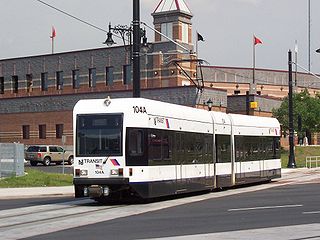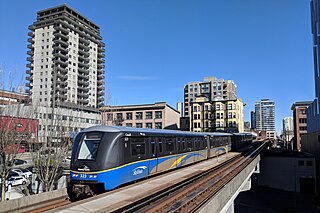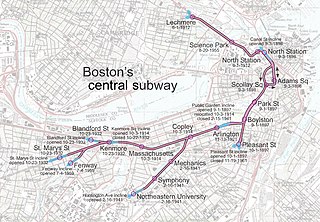Central subway may refer to:

The Newark Light Rail (NLR) is a light rail system serving Newark, New Jersey and surrounding areas, operated by New Jersey Transit Bus Operations. The service consists of two segments, the original Newark City Subway (NCS), and the extension to Broad Street station. The City Subway opened on May 16, 1935, while the combined Newark Light Rail service was officially inaugurated on July 17, 2006.

The Toronto subway is a rapid transit system serving Toronto and the neighbouring city of Vaughan in Ontario, Canada, operated by the Toronto Transit Commission (TTC). It is a multimodal rail network consisting of three heavy-capacity rail lines operating predominantly underground, and one elevated medium-capacity rail line. As of December 2022, three new lines are under construction, two light rail lines and one light metro line.

Kaohsiung Metro is a rapid transit and light rail system covering the metropolitan area of Kaohsiung, Taiwan. Its rapid transit network is known as Kaohsiung Mass Rapid Transit or Kaohsiung MRT. Construction of the MRT started in October 2001. The MRT opened in 2008 and the Circular light rail in 2015. Kaohsiung Metro is operated by the Kaohsiung Rapid Transit Corporation under a BOT contract the company signed with the Kaohsiung City Government.

Muni Metro is a light rail system serving San Francisco, California, United States. Operated by the San Francisco Municipal Railway (Muni), a part of the San Francisco Municipal Transportation Agency (SFMTA), Muni Metro served an average of 157,700 passengers per weekday in the fourth quarter of 2019, making it the second-busiest light rail system in the United States.
59th Street station may refer to:
Various terms are used for passenger railway lines and equipment; the usage of these terms differs substantially between areas:

The Tel Aviv Light Rail is a planned mass transit system for the Tel Aviv metropolitan area in central Israel. The system will include different modes of mass transit, including rapid transit (metro), light rail transit (LRT), and bus rapid transit (BRT). Overseen by the government agency NTA, the project will complement the intercity and suburban rail network operated by Israel Railways.

The Metro SubwayLink is a rapid transit line serving the greater area of Baltimore, Maryland, in the United States, and is operated by the Maryland Transit Administration. The segment in Downtown Baltimore is underground, and most of the line outside the central city is elevated or at surface grade. In 2021, the line had a ridership of 1,667,400, or about 3,900 per weekday as of the second quarter of 2022.
The Lower Manhattan–Jamaica/JFK Transportation Project was a proposed public works project in New York City, New York, that would use the Long Island Rail Road's Atlantic Branch and a new tunnel under the East River to connect a new train station near or at the World Trade Center Transportation Hub site with John F. Kennedy International Airport and Jamaica station on the LIRR. It would allow for a one-seat, 36-minute-long ride between JFK Airport and Lower Manhattan, cut commuting times from Long Island by up to 40% and reduce crowding on the IRT Broadway–Seventh Avenue Line, IRT Lexington Avenue Line, IND Eighth Avenue Line, and BMT Broadway Line in Manhattan.

The T Third Street is a Muni Metro light rail line in San Francisco, California. It runs along the east side of San Francisco from Sunnydale to Chinatown, traveling in the median of Third Street for most of its length before entering the Central Subway as it approaches downtown. The line serves 22 stations, all of which are accessible. Most of the surface portion of the line runs in dedicated median lanes, though two portions operate in mixed traffic.

Sydney, the largest city in Australia, has an extensive network of passenger and freight railways. The passenger system includes an extensive suburban railway network, operated by Sydney Trains, a metro network and a light rail network. A dedicated freight network also exists. Future expansion of the light rail network includes the Parramatta Light Rail. Existing light rail services are the Inner West Light Rail and the CBD & South East Light Rail.
B Line, B-Line or Line B may refer to the following:

The Pittsburgh Light Rail is a 26.2-mile (42.2 km) light rail system in Pittsburgh, Pennsylvania, and surrounding suburbs. It operates as a deep-level subway in Downtown Pittsburgh, but runs mostly at-grade in the suburbs south of the city. The system is largely linear in a north-south direction, with one terminus near Pittsburgh's central business district and two termini in the South Hills. The system is owned and operated by Pittsburgh Regional Transit. The T is one of the surviving first-generation streetcar systems in North America, with the oldest portions of the network dating back to 1903 and the Pittsburgh Railways. It is also one of only three light rail systems in the United States that continues to use the broad 5 ft 2+1⁄2 in Pennsylvania Trolley Gauge on its lines instead of the 4 ft 8+1⁄2 instandard gauge. In 2021, the system had a ridership of 27,975,600.

The Regional Connector Transit Project is a transit project currently constructing a 1.9-mile (3.1 km) light rail tunnel for the Los Angeles Metro Rail system in Downtown Los Angeles. It is designed to connect the A Line and E Line, which currently end at 7th Street/Metro Center station, to the existing L Line and Union Station. When completed, the project will provide a one-seat ride into the core of Downtown for passengers on those lines who currently need to transfer, and it will reduce or eliminate transfers for many passengers traveling across the region via Downtown.

The history of rapid transit began in London with the opening of the Metropolitan Railway, which is now part of the London Underground, in 1863. By World War I, electric underground railways were being used in Athens, Berlin, Boston, Buenos Aires, Budapest, Glasgow, Hamburg, Istanbul, Liverpool, New York City, Paris, and Philadelphia.
Central line or Central Line may refer to:

The Massachusetts Bay Transportation Authority (MBTA) operates rapid transit, light rail, and bus rapid transit services in the Boston metropolitan area, collectively referred to as the rapid transit, subway, or the T system.

Rapid transit or mass rapid transit (MRT), also known as heavy rail or metro, is a type of high-capacity public transport generally found in urban areas. A rapid transit system that primarily or traditionally runs below the surface may be called a subway, tube, or underground. Unlike buses or trams, rapid transit systems are railways that operate on an exclusive right-of-way, which cannot be accessed by pedestrians or other vehicles, and which is often grade-separated in tunnels or on elevated railways.

Urban rail transit in Canada encompasses a broad range of rail mass transit systems, including commuter rail, rapid transit, light rail, and streetcar systems.

Boston's central subway is the system of tunnels through which the MBTA Green Line operates light rail transit service in the urban core of the city. The central subway comprises several tunnels built at different times, including the Tremont Street subway, the Boylston Street subway, and the Huntington Avenue subway.